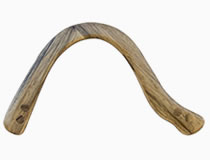Grip
Take the boomerang so that the front side is facing you, and the flat side is away from you. The grip of the boomerang can be different, the main thing is that it is convenient and allows you to make an accurate throw. You can take it with your full hand or pinch it with your fingers.
The boomerang can be held by the leading wing or the wingman. On some models, this leads to more or less intense rotation in flight, which in turn slightly affects the flight path. You can try both options.


Boomerang tilt
The slope of the boomerang strongly depends on its type and shape. For Classic boomerangs, the angle is usually 5 - 30 degrees, i.e. the throw is carried out closer to the vertical plane.
For long-range boomerangs (LD), the slope is from 50 to 80 degrees, i.e. the launch is made closer to the horizontal plane. Learn more about throwing LD boomerangs
Errors
Launching at an angle close to 90 degrees (flat) - the boomerang will immediately begin a rapid ascent followed by uncontrolled flight.
At a very small angle close to 0, the boomerang can fall without having time to align for normal flight.
Horizontal angle
Basically, the throw is carried out slightly above the horizon line, and depends on weather conditions. Increasing the launch angle slightly changes the trajectory. You can experiment with this.


Wind
The wind can greatly affect the flight path of the boomerang and its return.
The launch is carried out in calm weather or with a weak stable wind at a speed of up to 3 m/s. The throw must be made against the wind, at an angle of about 45 degrees to the right.
Errors
Launching in a strong wind - the boomerang is almost impossible to control, the trajectory is unpredictable.
Launching at the wrong angle to the wind - the boomerang flies away from the thrower.
Boomerang fishing
It is worth catching a boomerang only if you are sure that you control the trajectory of its flight, it has a low speed and a position convenient for being caught. The capture is carried out with two hands.




